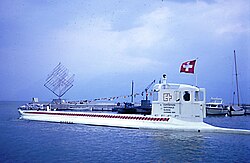Auguste Piccard (PX-8)
|
PX-8 in the port of Lausanne, 1964
|
||||||||||
|
||||||||||
|
||||||||||
|
||||||||||
|
||||||||||
The Auguste Piccard (name PX-8 , often also referred to as Mésoscaphe ) is a mesoscaphe that the Swiss oceanographer Jacques Piccard had built for the national exhibition Expo 64 in Lausanne in 1964 and named after his father Auguste Piccard , who also developed the idea for it . It was the first and to date the largest submarine built for tourism and scientific purposes, as well as the largest non-military underwater vehicle.
Auguste Piccard developed the mesoscaph concept in 1953. The boat was built in Monthey from 1962 to 1964 as the only submarine in Switzerland that was ever exclusively produced and registered there. The PX-8 was one of the symbols of the national exhibition and went on excursions in Lake Geneva from April to October with up to 40 passengers. These lasted up to 35 minutes, the boat made a maximum of nine trips per day. During these dives at a depth of up to 150 m, however, the water pollution temporarily clouded the view. In total, the boat carried over 33,000 people on 1,100 dives throughout 1964. It was then used for tourism in Marseille from 1966 to 1969 , after which it was sold to Vancouver , where it was converted into a research boat. 1984 was shut down and in Galveston ( Texas hook). In 1999 a Swiss businessman bought the boat for CHF 35,000 and brought it back to the country. For the state exhibition in 2002, the boat was exhibited slightly rusted in Murten . In 2005, the deck of the PX-8 in Villeneuve on Lake Geneva was cut for transport and transferred to the Swiss Museum of Transport in Lucerne in November of that year .
The boat is made of steel , is 28.5 m long and weighs 165 t. Inside, the PX-8 had a diameter of 3.1 m. The pressure hull allowed dives to a depth of 750 m, theoretically even 1,500 m would have been possible. A 58.8 kW electric motor propelled the boat and enabled a top speed of 6 knots . The battery and oxygen supply were sufficient for 48 hours of autonomous driving. The crew consisted of five people.
In 1976 the submarine was extensively modified in the USA for scientific work. The rows of seats for the passengers were removed, the machinery modified, the pressure hull made lighter and the tower rebuilt. Overall, the weight of the boat was reduced to 124 t and the maximum operating time was reduced to 16 hours. In addition, the speed increased slightly to 6.3 knots, and the maximum permitted diving depth was 610 m. Instead of passengers, the number of people on board now included 6 crew members and scientists. For the exhibition in the Museum of Transport, the exterior was largely restored to its original condition from 1964 by 2014.
literature
- Norbert Gierschner: diving boats . Interpress / VEB publishing house for transport, Berlin 1980
- Jacques Piccard: Le mésoscaphe Auguste Piccard . Lausanne 1968
Web links
- The Auguste Piccard in the Swiss Museum of Transport
- Article by Helmut Stalder on the restoration of the PX-8 August Piccard in the magazine Observer 25/08
Footnotes
- ↑ Jacques Piccard and his Mesoscaphe , Schweizer Fernsehen: Antenne, January 9, 1963
- ↑ Helmut Stalder: Looking back: "Send 300 kilos of journalists!" In: Neue Zürcher Zeitung of July 10, 2017
Coordinates: 47 ° 3 '7.3 " N , 8 ° 20' 13.4" E ; CH1903: six hundred and sixty-eight thousand two hundred and sixty-four / 211613

